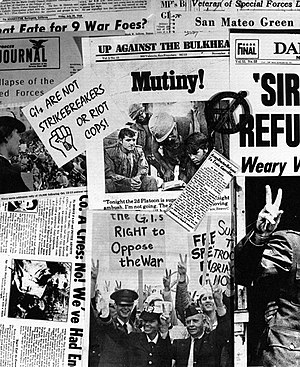| G.I. movement | |
|---|---|
| Part of the Opposition to U.S. involvement in Vietnam | |
 Publications from the GI movement, taken from the book A Matter of Conscience. | |
| Date | 1964–1973 |
| Caused by | United States Involvement in the Vietnam War |
| Goals | Avoid military duties in the Vietnam War |
| Methods |
|
| Resulted in |
|
The G.I. movement was the resistance to military involvement in the Vietnam War from active duty soldiers in the United States military.[1][2][3] Within the military popular forms of resistance included combat refusals, fragging, and desertion. By the end of the war at least 450 officers were killed in fraggings,[4] or about 250 from 1969–1971,[5] over 300 refused to engage in combat[6][unreliable source?] and approximately 50,000 American servicemen deserted.[7] Along with resistance inside the U.S. military, civilians opened up various G.I. coffeehouses near military bases where civilians could meet with soldiers and could discuss and cooperate in the anti-war movement.[3]
- ^ Kindig, Jessie. "GI Movement, 1968–1973: Special Section". University of Washington.
- ^ Seidman, Derek (June 1, 2016). "Vietnam and the Soldiers' Revolt The Politics of a Forgotten History". Monthly Review. Archived from the original on April 29, 2023.
- ^ a b Parsons, David (January 9, 2018). "How Coffeehouses Fueled the Vietnam Peace Movement". The New York Times.
- ^ Zoroya, Gregg; Gomez, Alan (May 11, 2009). "War-zone massacre an uncommon event". USA Today. Retrieved August 31, 2021.
- ^ Heinl, Robert D. Jr. (June 7, 1971). "The collapse of the armed forces". Armed Forces Journal. Retrieved August 31, 2021.
- ^ "'Fragging' and 'Combat Refusals' in Vietnam". History of U.S. Army Military Police in Vietnam. Archived from the original on June 26, 2021. Retrieved December 18, 2019.
- ^ "Vietnam War Resisters in Canada Open Arms to U.S. Military Deserters". Pacific News Service. June 28, 2005. Archived from the original on August 15, 2009.